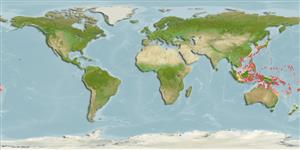Common names from other countries
Classification / Names / Names
Populärnamn | synonymer | Catalog of Fishes (gen., sp.) | ITIS | CoL | WoRMS
Environment: milieu / climate zone / depth range / distribution range
Ekologi
; djupintervall 6 - 20 m (Ref. 864). Tropical
Pacific Ocean.
Length at first maturity / Size / Vikt / Age
Maturity: Lm ? range ? - ? cm
Depth based on occurrence from Palau; to be replaced with a better reference (Ref. 864). Combination depth range: min from literature, max from estimate. Collected from the intertidal (Ref. 116475). Found offshore on sandy bottoms (Ref. 799).
Life cycle and mating behavior
Könsmognad | Reproduktion | Lek | Ägg | Fecundity | Larver
Members of the order Neotaenioglossa are mostly gonochoric and broadcast spawners. Life cycle: Embryos develop into planktonic trocophore larvae and later into juvenile veligers before becoming fully grown adults.
Smith, B.D. 2003. (Ref. 3116)
IUCN Red List Status (Ref. 130435)
CITES status (Ref. 108899)
Not Evaluated
Not Evaluated
Threat to humans
Harmless
Human uses
| FishSource |
Verktyg
Ytterligare information
Age/SizeTillväxtLength-weightLength-lengthMorfologiLarverAbundans
Internet-källor
Estimates based on models
Preferred temperature
(Ref.
115969): 21.2 - 29.3, mean 28.7 (based on 1392 cells).
